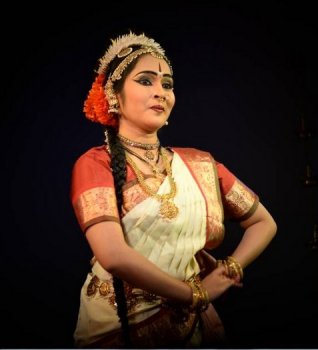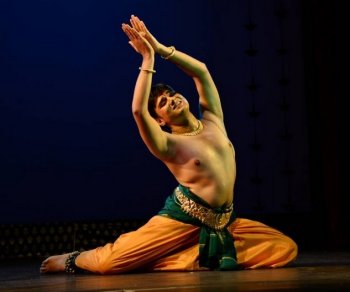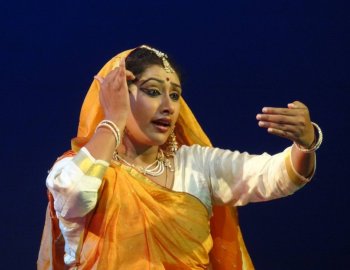
|   |

|   |
Shades of blue.... - Poornima Gururaja e-mail: kalasindhudance@gmail.com Photos: Nikhitha Manjunath, Srivatsa Shandilya, Prithvi Krishna March 24, 2015 ‘Krishna Premi,’ a two day thematic presentation was conceived by arts consultant Usha Rk. It was presented at the Malleswaram Seva Sadan in Bangalore on the 19th and 20th of March 2015. The idea was to bring out the different shades of love for Krishna through the eyes of Satyabhama, Rukmini, Kuchela, Draupadi, Radha and Meera. The festival opened with Harshini Bhoopathi Raju, disciple of Guru Manju Bhargavi, essaying the role of Satyabhama. The performance opened with the traditional patra parichaya of the character from behind a veil, in typical Kuchipudi style. As soon as the veil came off, one could not help but notice the unkempt braid, so primary to the character of Satyabhama. Threads hanging from the tied waist belt were a harsh distraction as the beautiful young dancer walked backwards. Although the dancer’s footwork seemed strong, it did not quite match with the nattuvangam. The young dancer put in sincere effort but looked like she was trying too hard. Glimpses of a swadeenapatika nayika came through here and there. She warmed up to “Rave Madhavi...” where she requests her sakhi to bring her to Krishna and ended up with the agony of Madana’s arrows which matched the discomfort of a discerning audience. The presentation can be described as a teal blue with shades of green or blue or both, diluting clarity. Rukmini followed with devout love. Keerthi Ramgopal, a more experienced dancer opened the presentation with a patra parichaya in a koutwam format, establishing Rukmini as a tulasi bhakta. The lines and stretches in her nritta delineation were geometric and precise. Clever use of sloka Kasturi Tilakam by a sakhi to describe Krishna to Rukmini, followed by her painting a picture of him and falling in love, set the stage for a well thought out piece. Intelligent use of stories of Govardhana Giridhara, and Kalinga Mardhana for the lines pani madhura paadam madhura were appropriate as was the choice of the piece itself (Madhurashtakam) because it is a composition of Srimad Vallabhacharya, a foremost follower of the Bhakti Marga. This enabled her to establish effortlessly the bhakti flavour of Rukmini's love. The use of “Bhuvana Sundara” to address Krishna as only Rukmini does, clearly indicated the dancer’s understanding of her character. The piece ended with a clear concise depiction of the tulabharam. What started with a tulasi pooja, ended with Rukmini forever establishing that devout love is greater by simply placing a tulasi leaf to balance out Sathyabhama’s wealth versus Krishna. A neat exacting circle. The appropriate use of ragas and literature by vocalist Nandakumar added to the piece. This performance was a navy blue night sky with depth and shining stars here and there  Harshini Bhoopathi Raju  Keerthi Ramgopal  Yogesh Kumar  Aditi Sadashiva Yogesh Kumar’s Kuchela was a shade of azure blue of a day sky. An expanse of breadth, very little depth. It was heartening to see such a young talented dancer tackle such a complex character as Kuchela. Although it looks at the outset like a story of unstinting friendship (sakya prema), it is layered with social, economic and intellectual differences between the two friends. He opened his piece with the blossoming of the friendship in the Sandeepani Ashram, followed by the separation of the friends after completion of their education. The second half saw the friends meeting and the famous scene of sharing of “poha,” one of Krishna's favorite foods. His effort was innocent, sincere and very apt for his level of experience. If he continues to perform over and over again, he has the potential to explore the character in greater depth. A good first attempt. Aditi Sadashiva's portrayal of Draupadi was dramatic and powerful as the character should be. Matched in prowess, wealth and intellect to Krishna, she simply asks and receives. Her entry in a spectacular red and orange costume, designed by her Guru Sathyanarayana Raju, successfully established the character as beautiful, confident and powerful. Her sringara was just the opposite, delicate, anxious as one should be in a swayamvara and appropriate. The placing of the dice and the Parcheesi board, and the five faces of the Pandavas when she questions them as she is dragged into the court was unexpected, surprising and created a deep impact. The highlight was the appearance of the unending saree on her plea to Krishna to save her grace. The props gave it an operatic feel, and added dimension to the performance. Kudos to Shankarraman for the heart rending lyrics and music. The red of the volatility and vitality of the character of Draupadi added to the shade of blue, I would say lent to a purple, a royal shade for a royal performance. As dignified and royal as Draupadi was, Gowri Sagar's (another disciple of Sathyanarayana Raju) sprightly entry, immediately transported us to Gokul, and a playful atmosphere. Her sensational costume in three bright colors was reflective of the Radha of Brindavan. With huge expressive eyes, she stole the hearts of the audience, while playing the part of stealing Krishna’s. The gamut of nayikas she portrayed form the Vasakasajja, who dresses unusually in Krishna's attire, to the virahotkantita or the khandita were impactful and transitioned with grace and ease. The fresh movements incorporated into the raas were impactful. From a playful Radha of Gokul to the desolate Radha as Krishna left for Mathura, she ran through a gamut of intense emotions. Her abhinaya, slow and deliberate at times and swift and precise at others, left a packed house at Seva Sadan spellbound. Her performance had color, clarity, depth and cuts that created brilliance. Her performance was a sapphire blue, a true gem  Gowri Sagar  Sowmya Somashekar Sowmya Somashekar, a disciple of Kathak duo Nirupama and Rajendara, had worked with Nagaraj to put together a piece on Meera. It was a continuation of the pathos of Radha, as Meera implored with Rana, that all she could do was sing the praises of Krishna. Vaidyaji's tabla and Raghunandan's flute all added to the performance. Her “Jo tum todo Piya” however was just plain explanation of the lyrics and did not add to elevate the performance. The essence of a “prem diwani” fell a bit short. The balance between pathos and ecstasy were not balanced enough. Pathos took over. The performance was a turquoise blue. A gem still, with not much of a shine. The music ensemble included Vasudha Balakrishna on the vocals on both days. She demonstrated her versatility by singing for Kuchipudi, Bharatanatyam and Kathak. Shakuntala Prabhat, nattuvanar, ably supported the team. S. V. Balakrishna on the mridangam, Vaidyaji on the tabla and Raghunandan on the flute were impressive. Sathyanarayana Raju created a classy stage, as he did heart rending choreographies for his disciples. Due credit should be given to Usha Rk for consistently creating patronage and stages for young artistes with thematic and creative ideas, on some unusual themes. She has made the effort to put her artists in touch with resource people in order to enable them to effectively communicate ideas of the themes. The performance was threaded through with thought and clarity. Timing of the performances were apt, so the audience did not feel compelled to leave as they usually do in Bangalore. A punctual start and finish, and expert organization gave us a two day treat to the “Shades of Blue” of none other than Neela Megha Shyama. The event was presented by Sadguru Sri Thyagabrahma Aradhana Kainkarya Trust, Bangalore, of which Usha Rk is a trustee. Poornima Gururaja is the Director, Kalasindhu Academy of Dance and Related Arts, Bangalore. |